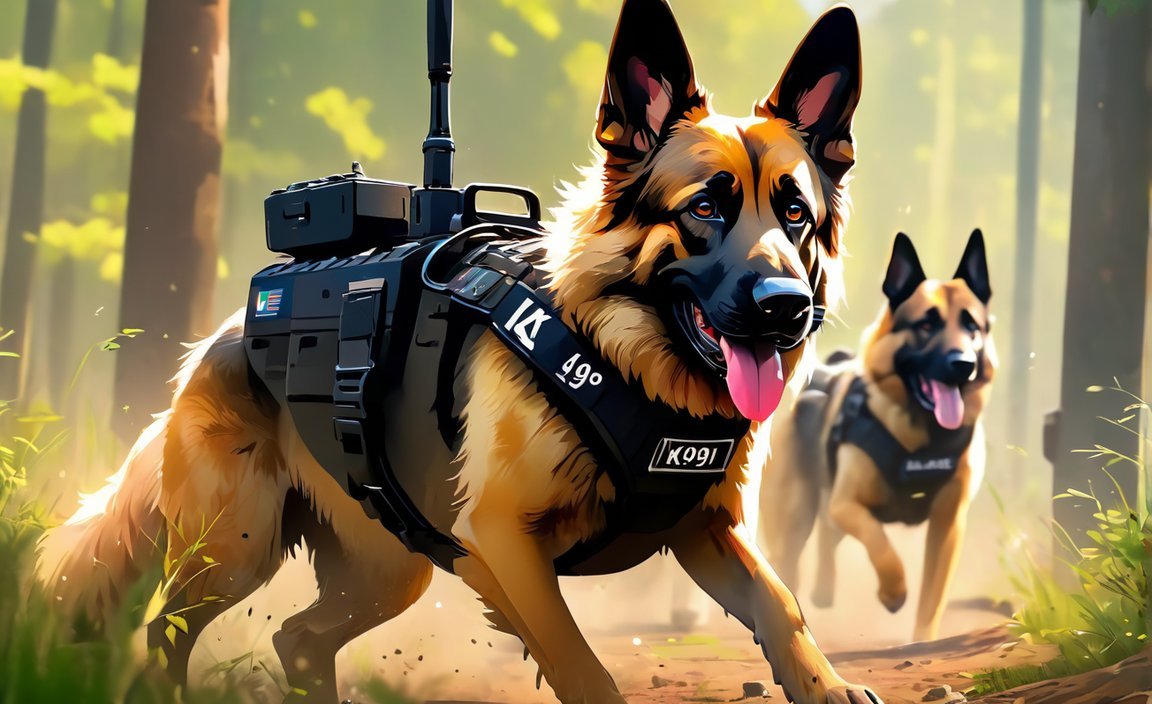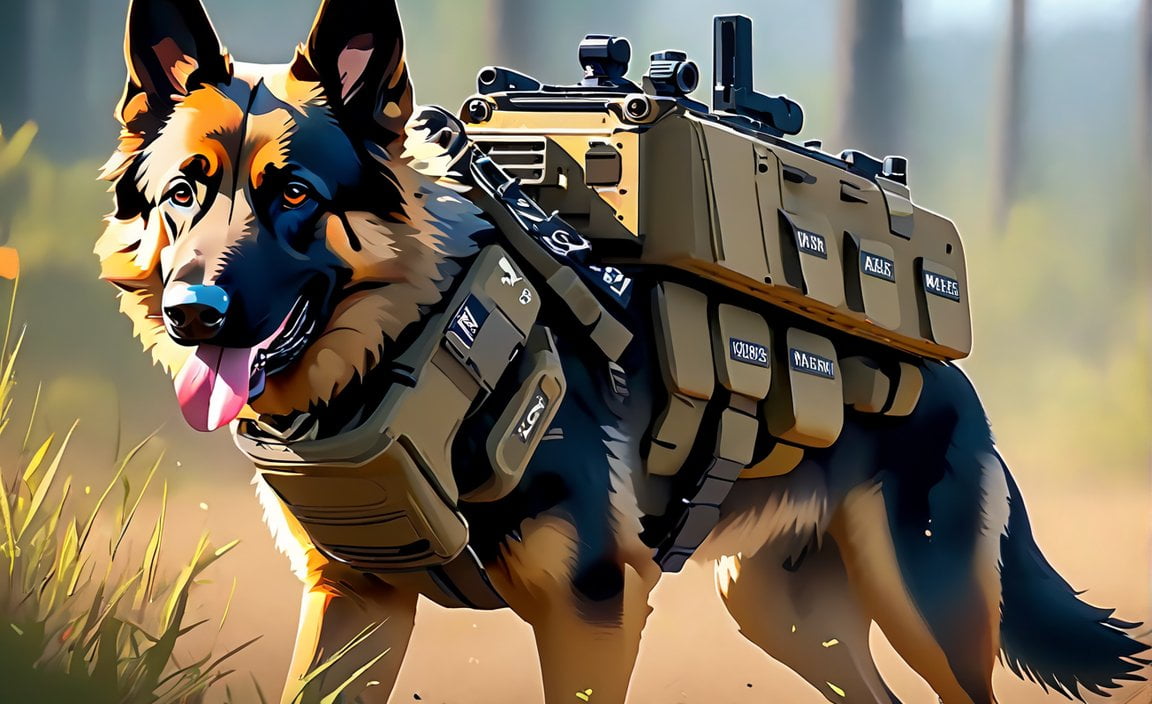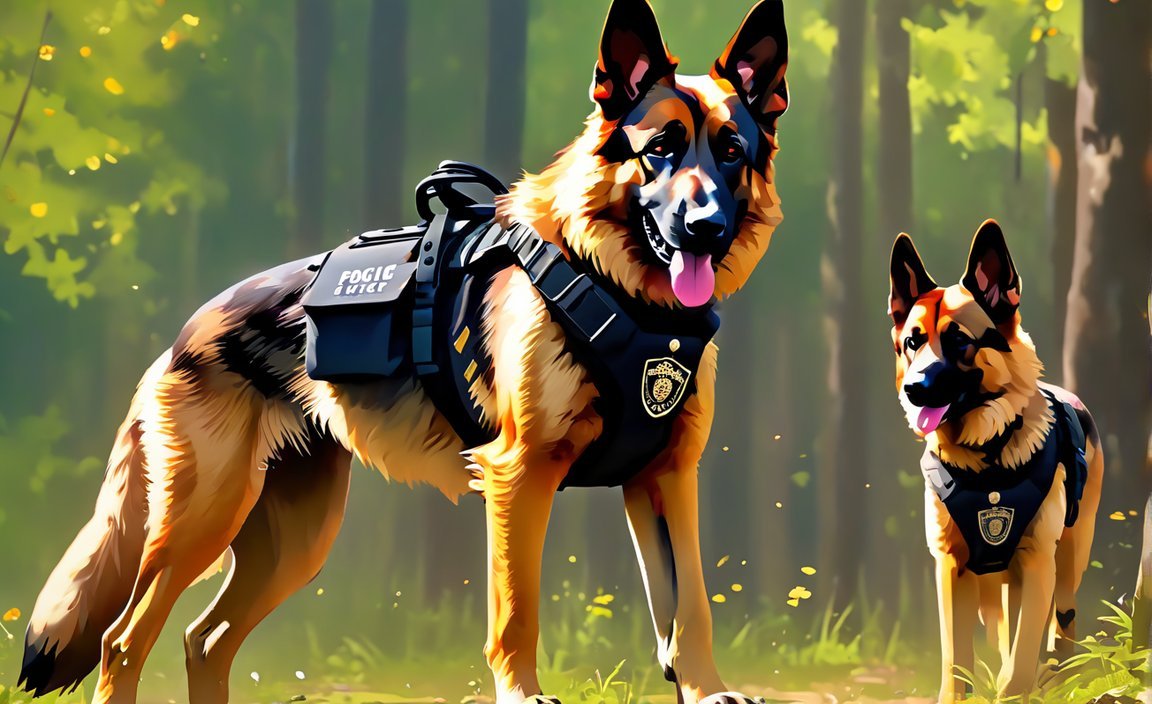The Role of K9 Police Dogs

K9 police dogs, also known as police dogs or service dogs, are an integral part of law enforcement agencies worldwide. These canine companions play a crucial role in assisting police officers in a variety of tasks, from apprehending suspects to detecting explosives and drugs. Their keen senses, unwavering loyalty, and exceptional training make them invaluable assets in the fight against crime.
10 Fascinating Facts About K9 Police Dogs

1. Rigorous Training and Sworn Officer Status
A Path to Excellence: The Rigorous Training of K9 Police Dogs
K9 police dogs, the canine counterparts to their human partners in law enforcement, embark on a rigorous training journey that transforms them into exceptional crime-fighters. This intensive process, spanning up to a year, instills in these remarkable dogs the skills and discipline necessary to excel in their demanding roles.
From the moment they are selected, K9 police dogs undergo a comprehensive assessment of their temperament, intelligence, and physical capabilities. Only those dogs exhibiting exceptional aptitude are chosen to proceed with formal training.
The training curriculum for K9 police dogs is meticulously designed to develop a wide range of essential skills, including:
- Obedience: K9 police dogs must be able to flawlessly execute commands under varying conditions, amidst distractions and in high-pressure situations.
- Scent Detection: Their keen sense of smell is honed to identify and locate specific odors, such as explosives, drugs, and accelerants, even in trace amounts.
- Apprehension: K9 police dogs are trained to safely and effectively apprehend suspects using a controlled bite, demonstrating their protective instincts and unwavering loyalty.
- Socialization and Adaptability: Exposure to diverse environments, interactions with the public, and desensitization to loud noises and sudden movements are crucial for K9 police dogs to operate effectively in various settings.
Earning the Badge: Sworn Officer Status
Upon successful completion of their training, K9 police dogs are formally recognized as sworn officers, a testament to their dedication, skill, and unwavering commitment to serving the law. This designation not only honors their contributions but also underscores the critical role they play in law enforcement.
K9 police dogs, alongside their human partners, stand as guardians of the law, their unwavering loyalty, exceptional abilities, and rigorous training making them indispensable assets in the fight against crime.
2. Training Starts at 12-15 Months: The Optimal Time for K9 Excellence
The journey of a K9 police dog begins at a crucial stage of canine development – between 12 and 15 months of age. This period marks a critical phase in their physical and mental maturation, making them well-prepared to embark on their rigorous training.
At this age, dogs have developed the necessary strength, stamina, and cognitive abilities to handle the demands of police work. Their bodies are sufficiently robust to withstand the physical rigors of training, while their minds are receptive to learning and retaining complex commands.
This optimal window of development allows K9 police dogs to fully absorb the intricacies of their training, laying the foundation for their future success. They become adept at following instructions, tracking scents, and apprehending suspects, all while maintaining their unwavering loyalty and unwavering dedication to their work.
Furthermore, the initiation of training during this period coincides with the dog’s natural inclination to explore and learn. Their curiosity and eagerness to engage with their trainers make them highly motivated and receptive to the training process.
By beginning their serious police training between 12 and 15 months of age, K9 police dogs are set on a path to excellence, their physical and mental faculties aligned to become exceptional crime-fighting partners.
3. A Six to Nine-Year Career: A Legacy of Service and Dedication
K9 police dogs, like their human counterparts, embark on a dedicated career, typically spanning six to nine years. During this remarkable tenure, they tirelessly serve their communities, upholding the law and protecting the lives of those they are sworn to protect.
The physical and mental demands of police work necessitate a carefully considered career length for K9 police dogs. By the end of their service, their bodies may exhibit signs of wear and tear, while their cognitive abilities may not be as sharp as they once were. Retiring these exceptional canines at an appropriate time ensures their well-being while preserving their legacy of service.
However, their contributions extend far beyond their active years. Many retired K9 police dogs find loving homes, where they continue to provide companionship and affection, forever cherished for their unwavering loyalty and dedication.
The six to nine years spent in active service represent a testament to the unwavering commitment of K9 police dogs. They embody the spirit of law enforcement, demonstrating courage, resilience, and an unwavering commitment to protecting their communities. Their legacies live on, not only in the lives they have touched but also in the hearts of their human partners and the communities they have served with distinction.
4. Second Chances from Animal Shelters: Unleashing Hidden Potential
Not all K9 police dogs embark on their remarkable journeys from pristine breeding kennels. Some, like their human partners, find their paths to greatness through unexpected channels – animal shelters. These dogs, often overlooked and underestimated, possess the innate qualities and potential to excel in police work, given a second chance to shine.
Animal shelters provide a sanctuary for countless dogs, many of whom exhibit exceptional intelligence, trainability, and unwavering loyalty. These traits, often masked by their circumstances, align perfectly with the requirements of a K9 police dog.
Shelter dogs bring a unique perspective to the K9 unit, having already experienced life’s challenges and developed a resilience that serves them well in their new roles. They possess a deep-seated desire to connect with their human handlers, demonstrating an eagerness to please and a willingness to learn.
Moreover, shelter dogs often possess a heightened sense of awareness and adaptability, having navigated diverse environments and interacted with a variety of individuals. These qualities make them well-suited for the unpredictable nature of police work.
By selecting K9 police dogs from animal shelters, law enforcement agencies not only harness the untapped potential of these remarkable dogs but also contribute to a noble cause – animal welfare. Providing these dogs with a second chance not only rewrites their own narratives but also serves as an inspiration to others, demonstrating the transformative power of second chances.
The stories of K9 police dogs who originated from animal shelters are a testament to the unwavering spirit and potential that lie within every dog. They serve as beacons of hope, reminding us that greatness can emerge from unexpected places, and that even those who have faced challenges can rise to become exceptional members of society.
5. Unique Abilities for Search and Detection: Canine Superpowers in Action
K9 police dogs possess an arsenal of unique abilities that make them invaluable assets in law enforcement. Their exceptional senses, unmatched agility, and unwavering dedication enable them to surpass human capabilities in search and detection tasks, making them indispensable partners in the fight against crime.
Navigating Impeded Environments
K9 police dogs are not limited by the same physical constraints as their human counterparts. They can maneuver through cramped spaces, traverse uneven terrain, and scale obstacles that would hinder human progress. This exceptional agility allows them to access areas that would be inaccessible to human officers, expanding the scope of search and detection operations.
Unparalleled Sensory Acuity
The olfactory prowess of K9 police dogs is legendary. Their sense of smell is estimated to be up to 100,000 times more acute than that of humans, enabling them to detect minute traces of odors that would be undetectable to the human nose. This exceptional ability allows them to locate explosives, drugs, and other concealed substances, even in the most challenging environments.
Unrelenting Drive and Dedication
K9 police dogs possess an unwavering drive to locate and identify target odors. Their motivation is not merely driven by training or obedience; it is deeply rooted in their innate instincts and their unwavering loyalty to their human handlers. This relentless pursuit of their objectives makes them exceptional partners in search and detection missions.
Through their unique abilities and unwavering dedication, K9 police dogs play a pivotal role in safeguarding our communities. Their ability to access restricted areas, detect minute traces of odors, and maintain relentless focus has proven invaluable in numerous law enforcement operations. They serve as a testament to the remarkable capabilities of our canine companions and the enduring bond between humans and dogs.
6. A Long History of Service: A Legacy of Canine Excellence in Law Enforcement
The partnership between K9 police dogs and law enforcement agencies stretches back over a century, a testament to the enduring value and exceptional contributions of these canine companions. This remarkable collaboration began to take shape around 1899, when formal police training programs for K9s emerged.
Prior to this era, dogs were often informally employed by law enforcement, relying on their natural instincts and untrained abilities to assist in various tasks. However, the recognition of their potential and the need for standardized training led to the development of structured programs that transformed these canine partners into indispensable members of police units.
Over the past 100 years, K9 police dogs have proven their worth time and again, demonstrating their exceptional capabilities in a wide range of law enforcement applications. Their keen senses, unwavering loyalty, and unwavering dedication have made them invaluable assets in search and detection, apprehension, and crowd control operations.
The long history of service between K9 police dogs and law enforcement is a testament to their remarkable versatility and adaptability. They have seamlessly integrated into the ever-evolving landscape of law enforcement, continuously adapting their skills and training to meet the challenges of modern policing.
Today, K9 police dogs remain an integral part of law enforcement agencies worldwide. Their presence is a symbol of expertise, dedication, and the enduring bond between humans and their canine companions. Their legacy of service is a testament to their exceptional contributions and unwavering commitment to upholding the law.
7. German Shepherds: The Epitome of Canine Excellence in Law Enforcement
German Shepherds, with their renowned intelligence, unwavering loyalty, and exceptional trainability, have established themselves as the breed of choice for K9 police work. Their innate qualities and adaptability have made them indispensable partners in law enforcement for over a century.
From the early days of formal K9 training, German Shepherds quickly emerged as the preferred breed, demonstrating their remarkable aptitude for various law enforcement tasks. Their sharp intellect allows them to grasp complex commands and adapt to different environments, while their unwavering loyalty and eagerness to please make them highly motivated and responsive to their handlers.
German Shepherds possess a physical prowess that aligns perfectly with the demands of police work. Their athleticism and agility enable them to navigate diverse terrains, pursue suspects, and apprehend offenders with remarkable efficiency. Their powerful bite serves as a deterrent and a tool for apprehension, while their keen sense of smell makes them invaluable in search and detection operations.
Over generations, German Shepherds have been selectively bred for their exceptional traits, further enhancing their suitability for police work. Reputable breeders prioritize temperament, intelligence, and trainability, ensuring that these dogs possess the necessary qualities to excel in demanding law enforcement roles.
German Shepherds have become synonymous with K9 police work, their presence a symbol of expertise, dedication, and the enduring bond between humans and their canine companions. Their remarkable contributions to law enforcement have earned them a place of honor and respect, solidifying their position as the breed of choice for K9 units worldwide.
8. The Power of a German Shepherd’s Bite: A Force Multiplier for Law Enforcement
German Shepherd police dogs are renowned for their exceptional bite force, a powerful tool that serves as a deterrent, a means of apprehension, and a protective shield for their human handlers. The sheer strength of their bite, capable of generating up to 1,500 pounds per square inch of pressure, makes them formidable adversaries in confrontational situations.
This impressive bite force is a result of their muscular jaw structure, sharp teeth, and powerful closing muscles. It is a testament to their natural instincts, honed over generations to subdue prey and protect their territory.
In the hands of a trained K9 handler, a German Shepherd’s bite is not a weapon of aggression but a carefully controlled tool employed with precision and restraint. It is used primarily as a last resort, when other means of apprehension have failed or when the safety of officers or the public is at risk.
The bite of a German Shepherd police dog serves as a powerful deterrent, discouraging suspects from resisting arrest and protecting officers from harm. The mere presence of these canine companions can often de-escalate volatile situations, preventing the need for more forceful intervention.
German Shepherd police dogs undergo rigorous training to ensure that their bite is used appropriately and effectively. They are taught to bite and hold suspects without causing undue injury, and they are conditioned to respond to verbal commands to release their grip.
The combination of exceptional bite force, extensive training, and unwavering loyalty makes German Shepherd police dogs invaluable assets in law enforcement. Their ability to apprehend suspects and protect officers is a testament to their remarkable capabilities and the enduring bond between humans and their canine companions.
9. A Dog’s Keen Sense of Smell: An Olfactory Advantage for Law Enforcement
K9 police dogs possess an extraordinary sense of smell, far surpassing that of humans. Their olfactory prowess, estimated to be up to 100,000 times more acute than our own, enables them to detect minute traces of odors that would be imperceptible to the human nose. This remarkable ability makes them indispensable partners in law enforcement, particularly in search and detection operations.
The olfactory advantage of K9 police dogs lies in their unique anatomy and physiology. Their noses contain approximately 300 million olfactory receptors, compared to a mere 6 million in humans. These receptors are highly sensitive and capable of detecting a vast array of volatile organic compounds (VOCs), the molecules that emit odors.
Moreover, the nasal passages of K9 police dogs are lined with specialized cells that transport odor molecules directly to the olfactory bulb, the part of the brain responsible for processing smell. This direct pathway ensures that odor information is rapidly and efficiently transmitted, enabling dogs to detect and identify scents with remarkable speed and accuracy.
The exceptional sense of smell of K9 police dogs has been harnessed to detect a wide range of illicit substances, including drugs, explosives, and accelerants. Their ability to locate these hidden items, even in trace amounts, has proven invaluable in drug interdiction, bomb detection, and arson investigations.
Beyond their role in detecting illicit substances, K9 police dogs are also employed to locate missing persons, track fleeing suspects, and identify specific individuals in lineups. Their keen sense of smell allows them to follow scent trails, identify specific odors associated with individuals, and locate hidden evidence that may have been overlooked by human investigators.
The extraordinary sense of smell possessed by K9 police dogs is a testament to their remarkable evolutionary adaptations. Their olfactory prowess, honed over millennia, has made them indispensable partners in law enforcement, providing a unique and invaluable asset in the fight against crime.
10. Unsurpassed Search Speed: A Canine Advantage for Efficient Search Operations
K9 police dogs possess an unmatched ability to search an area four times faster than any human. This remarkable speed, coupled with their exceptional sense of smell and unwavering focus, makes them indispensable assets in search and rescue operations, crime scene investigations, and tracking suspects.
The unparalleled search speed of K9 police dogs stems from their unique physical and behavioral traits. Their agile bodies, powerful muscles, and exceptional stamina allow them to cover vast areas of ground with remarkable efficiency. Their keen sense of smell enables them to detect and follow scent trails with precision, even in challenging environments.
Moreover, K9 police dogs possess an unwavering focus and dedication to their tasks. They are trained to ignore distractions and maintain fixed concentration on the search objective, whether it’s locating missing persons, detecting hidden evidence, or tracking fleeing suspects.
The combination of their physical prowess, olfactory acuity, and unwavering focus allows K9 police dogs to search an area with unparalleled speed and efficiency. They can rapidly traverse diverse terrains, detect subtle scent cues, and identify hidden objects that would remain elusive to human searchers.
In search and rescue operations, K9 police dogs are often the first responders, their speed and accuracy crucial in locating lost or injured individuals. Their ability to navigate rough terrain and detect faint odors has saved countless lives.
In crime scene investigations, K9 police dogs play a vital role in locating and identifying hidden evidence. Their keen sense of smell allows them to detect minute traces of blood, DNA, and other forensic materials that may be overlooked by human investigators.
In tracking suspects, K9 police dogs can follow scent trails over long distances, even through dense vegetation and challenging terrain. Their ability to maintain focus and track scents persists even in adverse weather conditions.
The unsurpassed search speed of K9 police dogs is a testament to their remarkable capabilities and the enduring bond between humans and their canine companions. Their contributions to search and rescue operations, crime scene investigations, and tracking suspects have proven invaluable in upholding the law and protecting our communities.
Conclusion
K9 police dogs are an invaluable asset to law enforcement agencies around the world. Their intelligence, loyalty, and unique abilities make them indispensable partners for police officers. As we continue to face new challenges in the fight against crime, K9 police dogs will continue to play an important role in keeping our communities safe.
- Explore the exciting world of law enforcement with these intriguing 10 facts about K9 police dogs and discover the crucial role they play in ensuring our safety and security.
- Curious about our avian companions? Delve into the fascinating realm of 10 extinct birds in India and learn about the unique species that once graced the Indian skies.
- Interested in the biodiversity of South Asia? Discover the secrets of 10 extinct species in Pakistan and their significance in the natural history of the region.
- Ready to embark on a journey into the equestrian world? Uncover the wonders of 10 facts about horse riding and explore the art and science of horseback riding.
FAQ
Q1: What is the role of K9 police dogs?
K9 police dogs, also known as police dogs or service dogs, play a crucial role in assisting law enforcement agencies in a variety of tasks, including:
- Apprehending suspects: K9 police dogs are trained to track suspects and apprehend them with their powerful bites.
- Detecting explosives and drugs: K9 police dogs have an incredible sense of smell, making them invaluable for detecting explosives and drugs in airports, public buildings, and other sensitive locations.
- Searching for missing persons: K9 police dogs are often used to search for missing persons, especially in large or difficult-to-navigate areas.
- Providing crowd control: K9 police dogs can be used to control crowds and deter potential riots or violence.
Q2: How long does it take to train a K9 police dog?
The training of a K9 police dog can take up to a year. During this time, the dog will be trained to obey commands, track scents, and apprehend suspects. They will also be trained to socialize with the public and be comfortable in a variety of environments.
Q3: What are some of the most common breeds of K9 police dogs?
The most common breeds of K9 police dogs include:
- German Shepherds: German Shepherds are known for their intelligence, loyalty, and trainability, making them ideal for police work.
- Belgian Malinois: Belgian Malinois are similar to German Shepherds, but they are slightly smaller and more agile.
- Bloodhounds: Bloodhounds are known for their exceptional sense of smell, making them invaluable for tracking suspects and missing persons.
- Labrador Retrievers: Labrador Retrievers are intelligent, friendly, and easy to train, making them well-suited for tasks such as drug detection and explosives detection.
Q4: What is the average career length of a K9 police dog?
The average career length of a K9 police dog is six to nine years. During this time, the dog will work tirelessly to protect their communities and uphold the law.
Q5: How can I learn more about K9 police dogs?
There are many resources available to learn more about K9 police dogs. You can visit the website of the American Kennel Club (AKC) or the National Police Dog Association (NPDA) to learn more about the training and capabilities of K9 police dogs. You can also watch documentaries or read books about K9 police dogs to gain a deeper understanding of their work.














